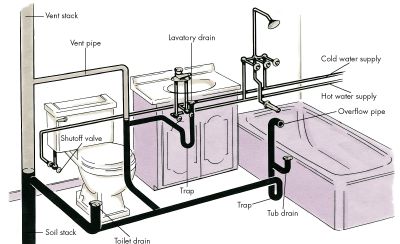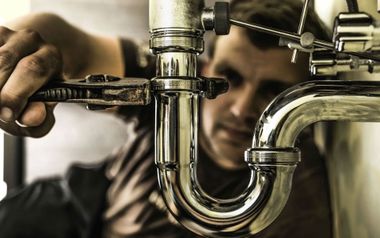Essential Insights About Your Home's Plumbing System Anatomy
Essential Insights About Your Home's Plumbing System Anatomy
Blog Article
This article further down in relation to The Inner Workings of Your Home's Plumbing is highly entertaining. You should keep reading.

Understanding just how your home's pipes system works is vital for every homeowner. From supplying clean water for drinking, food preparation, and showering to securely removing wastewater, a properly maintained pipes system is important for your family's wellness and comfort. In this thorough guide, we'll explore the detailed network that comprises your home's plumbing and deal ideas on upkeep, upgrades, and handling usual issues.
Intro
Your home's plumbing system is greater than simply a network of pipes; it's a complicated system that guarantees you have access to tidy water and efficient wastewater elimination. Knowing its parts and exactly how they interact can aid you stop costly fixings and make sure everything runs efficiently.
Basic Elements of a Plumbing System
Pipes and Tubes
At the heart of your pipes system are the pipes and tubes that bring water throughout your home. These can be constructed from different products such as copper, PVC, or PEX, each with its benefits in terms of longevity and cost-effectiveness.
Fixtures: Sinks, Toilets, Showers, and so on.
Components like sinks, bathrooms, showers, and bath tubs are where water is utilized in your house. Comprehending how these components link to the pipes system helps in detecting issues and intending upgrades.
Valves and Shut-off Factors
Shutoffs manage the circulation of water in your pipes system. Shut-off shutoffs are essential throughout emergency situations or when you need to make fixings, enabling you to separate parts of the system without disrupting water circulation to the entire residence.
Water Supply System
Key Water Line
The major water line links your home to the metropolitan supply of water or a private well. It's where water enters your home and is distributed to various fixtures.
Water Meter and Stress Regulatory Authority
The water meter measures your water usage, while a stress regulatory authority makes certain that water flows at a safe pressure throughout your home's plumbing system, stopping damages to pipes and fixtures.
Cold Water vs. Hot Water Lines
Understanding the distinction between cold water lines, which provide water straight from the major, and warm water lines, which carry heated water from the water heater, helps in troubleshooting and planning for upgrades.
Water drainage System
Drain Pipes Piping and Traps
Drain pipelines lug wastewater far from sinks, showers, and commodes to the sewage system or septic tank. Traps avoid drain gases from entering your home and likewise trap debris that could trigger blockages.
Air flow Pipes
Ventilation pipes allow air into the drain system, preventing suction that can reduce drainage and cause traps to empty. Correct ventilation is vital for maintaining the honesty of your plumbing system.
Value of Proper Drain
Making sure appropriate drain stops back-ups and water damages. Routinely cleaning drains and maintaining traps can avoid expensive repair work and extend the life of your pipes system.
Water Heater
Kinds Of Water Heaters
Water heaters can be tankless or conventional tank-style. Tankless heating units warm water as needed, while containers keep heated water for immediate use.
Just How Water Heaters Connect to the Plumbing System
Understanding just how hot water heater link to both the cold water supply and hot water distribution lines helps in diagnosing concerns like not enough hot water or leaks.
Upkeep Tips for Water Heaters
Consistently flushing your hot water heater to eliminate sediment, examining the temperature level settings, and inspecting for leaks can expand its life-span and enhance power performance.
Usual Pipes Issues
Leakages and Their Reasons
Leaks can take place due to aging pipelines, loose installations, or high water stress. Dealing with leaks without delay stops water damage and mold and mildew growth.
Clogs and Clogs
Blockages in drains pipes and bathrooms are usually brought on by flushing non-flushable things or an accumulation of oil and hair. Utilizing drain screens and bearing in mind what goes down your drains pipes can avoid obstructions.
Indications of Pipes Issues to Look For
Low tide pressure, slow-moving drains, foul odors, or abnormally high water bills are indicators of possible pipes problems that must be addressed promptly.
Plumbing Upkeep Tips
Regular Assessments and Checks
Schedule annual pipes evaluations to capture concerns early. Seek indications of leakages, deterioration, or mineral accumulation in taps and showerheads.
DIY Maintenance Tasks
Easy jobs like cleaning faucet aerators, looking for commode leaks utilizing dye tablets, or shielding exposed pipes in cool environments can avoid significant plumbing problems.
When to Call an Expert Plumber
Know when a plumbing problem calls for expert expertise. Attempting complicated fixings without proper knowledge can result in even more damage and higher repair service prices.
Updating Your Pipes System
Factors for Upgrading
Updating to water-efficient components or changing old pipelines can boost water quality, reduce water bills, and raise the worth of your home.
Modern Pipes Technologies and Their Benefits
Discover innovations like clever leakage detectors, water-saving bathrooms, and energy-efficient hot water heater that can conserve cash and lower ecological influence.
Cost Considerations and ROI
Determine the in advance expenses versus long-lasting cost savings when thinking about pipes upgrades. Several upgrades spend for themselves via lowered energy expenses and fewer fixings.
Ecological Influence and Preservation
Water-Saving Components and Home Appliances
Setting up low-flow faucets, showerheads, and toilets can substantially minimize water usage without sacrificing performance.
Tips for Reducing Water Use
Basic habits like fixing leakages immediately, taking much shorter showers, and running full loads of washing and meals can conserve water and lower your utility costs.
Eco-Friendly Pipes Options
Think about sustainable plumbing products like bamboo for flooring, which is durable and environmentally friendly, or recycled glass for countertops.
Emergency Readiness
Actions to Take During a Pipes Emergency situation
Know where your shut-off valves lie and exactly how to turn off the water supply in case of a ruptured pipe or major leakage.
Significance of Having Emergency Calls Helpful
Maintain get in touch with information for neighborhood plumbing technicians or emergency solutions easily available for fast action during a pipes dilemma.
Do It Yourself Emergency Fixes (When Applicable).
Short-term solutions like utilizing air duct tape to patch a dripping pipe or positioning a container under a leaking tap can reduce damages till an expert plumbing professional arrives.
Final thought.
Recognizing the composition of your home's plumbing system encourages you to keep it effectively, conserving time and money on repair services. By adhering to regular maintenance regimens and staying notified concerning modern plumbing modern technologies, you can guarantee your plumbing system operates efficiently for many years to find.
HOW YOUR PLUMBING SYSTEM WORKS
Which Pipes Do What?
Blue lines = fresh water supply entering the building
Red lines = hot water supply entering the building
Grey lines = pipes carrying waste away from the building and venting pipes carrying gases away from the building (through the roof)
YOUR MAIN PLUMBING SYSTEMS
There are two main plumbing systems that support your home s basic plumbing needs one that brings clean water into your home, and one that sends dirty water away from your home. Connected to the toilet, bath, shower, and other faucets in your home, these two systems keep your water flowing in the right directions.
ACCESSING FRESH WATER
Fresh and clean water is brought into your home through the main water supply line . Filtered through one pipe, this water is pressured to flow into the various fixtures in your home at any given time.
This water can be sourced from a well located on your property, a pond or river (mostly cottages), or, as in most cases, from the city s municipal water treatment centre. However, it is important to note that water that is untreated, such as the water siphoned from ponds or rivers, may not be safe to drink. Personal water supplies always need to be treated for hardness and contaminants before consumed.
MUNICIPAL WATER SUPPLIES
Improve taste and odour
Remove sediment
Eliminate hardness
Reduce chlorine
COLD WATER SUPPLY VS. HOT WATER SUPPLY
Cold water flows into your home or building through the service line, which then distributes hot or cold water to your fixtures. This line is most commonly run through a central column that runs floor to floor. Hot water runs in short and straight pipes as the longer the pipeline, the more heat that will be lost in the transfer. Having shorter pipes also allows residents to access hot water more quickly.
WASTE WATER SYSTEM
Your wastewater system is divided into two parts pipes that send wastewater away from your home and venting pipes that send sewer gas away from your home. Sewage water travels through pipes that flush the water and waste towards local sewers that are operated and managed by your city or town. Most sewer systems rely on gravity to move the wastewater to where it needs to go.
The further away from your toilet or sink, the larger wastewater pipes become. This allows for waste to be disposed of from various parts of your home or business at once without pipe blockages. The angle and flow of these pipes are also essential for keeping your waste pipes clear of build up.
https://harrisplumbing.ca/how-your-home-plumbing-system-works/

HOW YOUR PLUMBING SYSTEM WORKS
Which Pipes Do What?
YOUR MAIN PLUMBING SYSTEMS
There are two main plumbing systems that support your home s basic plumbing needs one that brings clean water into your home, and one that sends dirty water away from your home. Connected to the toilet, bath, shower, and other faucets in your home, these two systems keep your water flowing in the right directions.
ACCESSING FRESH WATER
Fresh and clean water is brought into your home through the main water supply line . Filtered through one pipe, this water is pressured to flow into the various fixtures in your home at any given time.
This water can be sourced from a well located on your property, a pond or river (mostly cottages), or, as in most cases, from the city s municipal water treatment centre. However, it is important to note that water that is untreated, such as the water siphoned from ponds or rivers, may not be safe to drink. Personal water supplies always need to be treated for hardness and contaminants before consumed.
MUNICIPAL WATER SUPPLIES
COLD WATER SUPPLY VS. HOT WATER SUPPLY
Cold water flows into your home or building through the service line, which then distributes hot or cold water to your fixtures. This line is most commonly run through a central column that runs floor to floor. Hot water runs in short and straight pipes as the longer the pipeline, the more heat that will be lost in the transfer. Having shorter pipes also allows residents to access hot water more quickly.
WASTE WATER SYSTEM
Your wastewater system is divided into two parts pipes that send wastewater away from your home and venting pipes that send sewer gas away from your home. Sewage water travels through pipes that flush the water and waste towards local sewers that are operated and managed by your city or town. Most sewer systems rely on gravity to move the wastewater to where it needs to go.
The further away from your toilet or sink, the larger wastewater pipes become. This allows for waste to be disposed of from various parts of your home or business at once without pipe blockages. The angle and flow of these pipes are also essential for keeping your waste pipes clear of build up.
https://harrisplumbing.ca/how-your-home-plumbing-system-works/
I'm just very inquisitive about The Inner Workings of Your Home's Plumbing and I am praying you appreciated the new blog entry. Enjoyed our write-up? Please quickly share it. Let someone else check it out. I truly appreciate reading our article about The Inner Workings of Your Home's Plumbing.
Click Here Report this page